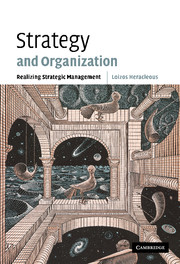Book contents
- Frontmatter
- Contents
- List of figures
- List of tables
- Preface
- I Bases of strategic management
- 1 The strategic management field
- 2 An organizational action view of strategic management
- 3 Strategic thinking or strategic planning?
- 4 Leadership research and the board of directors
- II Realizing strategy
- III Current themes and applications
- Index of names
- Index of subjects
- References
4 - Leadership research and the board of directors
Published online by Cambridge University Press: 11 May 2010
- Frontmatter
- Contents
- List of figures
- List of tables
- Preface
- I Bases of strategic management
- 1 The strategic management field
- 2 An organizational action view of strategic management
- 3 Strategic thinking or strategic planning?
- 4 Leadership research and the board of directors
- II Realizing strategy
- III Current themes and applications
- Index of names
- Index of subjects
- References
Summary
There is a plethora of research on leadership and on boards of directors from a variety of theoretical perspectives. Unfortunately, research within each of these domains has proceeded independently of each other, which has prevented potentially fruitful cross-fertilization between them. This chapter explores the relevance and applicability of leadership research in enhancing our understanding of boards of directors' functioning and effectiveness. Secondly, it discusses methodological issues with respect to board research and indicates potentially fruitful further approaches.
It is suggested that the leadership research stream focused on traits and competencies is particularly promising for future research on boards, since it has been demonstrated that there are traits that can distinguish leaders from non-leaders or effective leaders from ineffective ones, as well as being relevant competencies to distinguish superior performers from average performers in particular jobs. Consistent with the organizational action view of strategic management, this chapter aims to gain a deeper understanding of the dominant coalition, and shares the methodological perspective of this view. It is proposed that a promising way forward in terms of methodology is to focus on gathering in-depth qualitative longitudinal data of actual board behaviors and processes, based on observation. This in-depth data inform quantitative research so as to enhance the operationalization of theoretical variables, and to help identify the key variables in the first place.
- Type
- Chapter
- Information
- Strategy and OrganizationRealizing Strategic Management, pp. 53 - 70Publisher: Cambridge University PressPrint publication year: 2003



